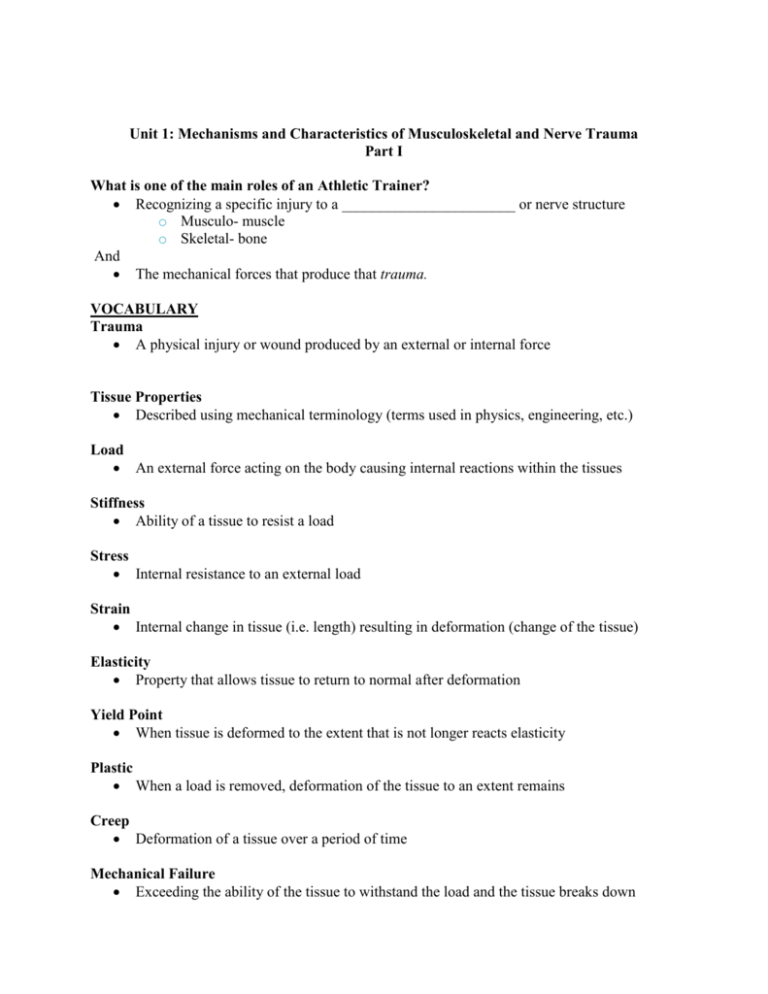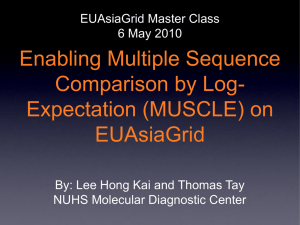Unit One Part I Student Notes
advertisement

Unit 1: Mechanisms and Characteristics of Musculoskeletal and Nerve Trauma Part I What is one of the main roles of an Athletic Trainer? Recognizing a specific injury to a _______________________ or nerve structure o Musculo- muscle o Skeletal- bone And The mechanical forces that produce that trauma. VOCABULARY Trauma A physical injury or wound produced by an external or internal force Tissue Properties Described using mechanical terminology (terms used in physics, engineering, etc.) Load An external force acting on the body causing internal reactions within the tissues Stiffness Ability of a tissue to resist a load Stress Internal resistance to an external load Strain Internal change in tissue (i.e. length) resulting in deformation (change of the tissue) Elasticity Property that allows tissue to return to normal after deformation Yield Point When tissue is deformed to the extent that is not longer reacts elasticity Plastic When a load is removed, deformation of the tissue to an extent remains Creep Deformation of a tissue over a period of time Mechanical Failure Exceeding the ability of the tissue to withstand the load and the tissue breaks down 5 Types of Tissue Loading Tension o Force that pulls and stretches tissue Compression o Force that results in tissue crush – two forces applied towards one another Shearing o Force that moves across the parallel organization of tissue Bending o Convex side is elongated and subject to tension while the concave side is subjected to compression resulting in shortening Torsion o Loads caused by twisting in opposite directions from opposite ends Traumatic vs. Overuse Injuries or Acute vs. Chronic Acute vs. chronic injuries Acute Injury o Something initiated the injury process (_________________________) Chronic Injury o When it doesn’t properly heal (________________________________________) Defined by mechanism Traumatic (i.e. a direct blow) vs. Overuse (i.e. repetitive dynamic use over time) Musculotendinous Unit (3 parts) Gross Anatomy Muscle o ______________________________________________ that produce movement Tendon o Thicker part of muscle that ___________________________________________ Fascia o Fibrous _________________________________________ (over the epimysium) Skeletal Muscle Diagram Muscle Injuries Muscle Strains Stretch, tear or rip to muscle or its tendon Cause: _______________________________________________ is the result of: o Coordination of agonist and antagonist o Electrolyte imbalance o Strength imbalance Grade I – o Some fibers have been _____________________ or actually torn Tenderness and pain on active ROM but full range Grade II – o Moderate Number of fibers have been torn o Active contraction is painful o ____________________________________ is palpable o Some swelling and discoloration result Grade IIIo _______________________________ of muscle o Significant impairment o Initially a great deal of pain that diminishes Rehabilitation o Healing time may be lengthy o Treatment and recovery may take 6-8 weeks depending on severity o Return to play too soon could result in re-injury Paraphrase the 3 Grades Grade I: Grade II: Grade III: Muscle Cramps Painful _____________________________ skeletal muscle contraction Cause: Can coincide with heat cramps due to excessive water loss or electrolytes Muscle Guarding Involuntary muscle contraction in ______________________________ following injury Elaboration: The muscles that surround the injured area contract or splint the area Muscle Spasm A _____________________________ caused by trauma Elaboration: May lead to muscle or tendon injuries Types o Clonic - _______________________________ involuntary muscular contractions and relaxations in quick succession o Tonic - ______________________________________ that lasts a period of time Muscle Soreness Pain caused by _____________________________ in exercise Elaboration: Generally occurs following participation in activity that individual is unaccustomed Two types: o Acute-onset muscle soreness Accompanies fatigue Pain experienced ________________________________ after exercise o Delayed-onset muscle soreness (DOMS) Pain that occurs _______________ hours following activity that gradually subsides Pain free 3-4 days later Tendon Injuries Tendons Connects muscle to bone Elaboration o Some elasticity (more than bone, less than muscle) o Breaking point occurs at 6-8% of increased length o Tears generally _____________________________ and not tendon Tendinitis _____________________________________ of the tendon Mechanism o Gradual onset, due to microtrauma of the tendon o Tendon becomes irritated Signs/ Symptoms: o Swelling, pain, warmth, and crepitus (crackling feeling or sound) Management: o Key to treatment is _____________ (substitute an activity) Tendonosis Break down of the tendon __________________________ Signs and Symptoms: o Less inflammation o ________________ movement or touching o Stiffness and restricted motion Management: o Stretching and strengthening Tenosynovitis Inflammation of the tendon _________________________________________ Types o Acute case: rapid onset, crepitus, and diffuse swelling o Chronic cases: result in thickening of tendon with pain and crepitus Myofascial Trigger Points Discrete, __________________________________________ within tight band of muscle or fascia (knots) Types o Latent trigger point Become aware when pressure is applied May restrict movement or cause muscle weakness o Active trigger point Causes pain at rest Applying pressure = pain = jump sign (w/ referred pn) Found mostly postural muscles Contusion ____________________________________________ tissue that results in bleeding into surrounding area, AKA- a bruise Mechanism: o Result of sudden blow to body o Can be both deep and superficial Signs and Symptoms: o Ecchymosis (_________________________________________ of the skin) o Pain with palpation and movement Myositis Ossificans Chronically inflamed and contused tissue may result in generation of ________________ __________________________ Bone spurs in the muscle Atrophy Muscle _____________________________________________ Due to immobilization, inactivity, or loss of nerve functioning Contracture Abnormal __________________________________ of muscle Usually due to scar tissue








